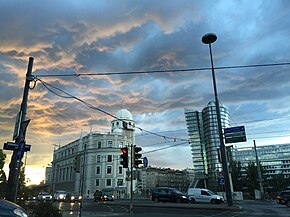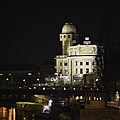
Vienna is the capital, most populous city, and one of nine federal states of Austria. It is Austria's primate city, with just over two million inhabitants. Its larger metropolitan area has a population of nearly 2.9 million, representing nearly one-third of the country's population. Vienna is the cultural, economic, and political center of the country, the fifth-largest city by population in the European Union, and the most-populous of the cities on the Danube river.

Urania was, in Greek mythology, the muse of astronomy and astrology. Urania is the goddess of astronomy and stars, her attributes being the globe and compass.

Rosa Albach-Retty was an Austrian film and stage actress.
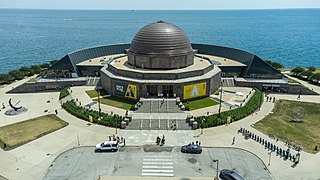
The Adler Planetarium is a public museum in Chicago, Illinois, dedicated to astronomy and astrophysics. It was founded in 1930 by local businessman Max Adler. Located on the northeastern tip of Northerly Island on Lake Michigan, the Adler Planetarium was the first planetarium in the United States. It is part of Chicago's Museum Campus, which includes the John G. Shedd Aquarium and The Field Museum. The Planetarium's mission is to inspire exploration and understanding of the universe.

The Vienna Ring Road is a 5.3 km circular grand boulevard that serves as a ring road around the historic Innere Stadt district of Vienna, Austria. The road is located on sites where medieval city fortifications once stood, including high walls and the broad open field ramparts (glacis), criss-crossed by paths that lay before them.

Valie Export is an avant-garde Austrian artist. She is best known for provocative public performances and expanded cinema work. Her artistic work also includes video installations, computer animations, photography, sculpture and publications covering contemporary art.

The Vienna Volksoper is an opera house in Vienna, Austria. It produces three hundred performances of twenty-five German language productions of opera, operetta, musicals, and ballet, during an annual season which runs from September through June.
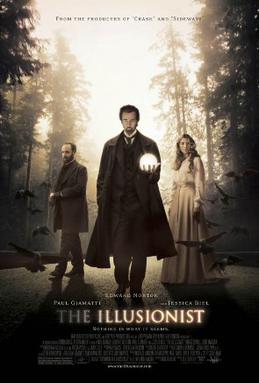
The Illusionist is a 2006 American romantic mystery film written and directed by Neil Burger and starring Edward Norton, Paul Giamatti, and Jessica Biel. Based loosely on Steven Millhauser's short story "Eisenheim the Illusionist", it tells the story of Eisenheim, a magician in turn-of-the-century Vienna, who reunites with his childhood love, a woman far above his social standing. It also depicts a fictionalized version of the Mayerling incident.
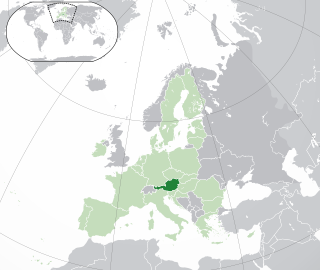
The history of the Jews in Austria probably begins with the exodus of Jews from Judea under Roman occupation. There have been Jews in Austria since the 3rd century CE. Over the course of many centuries, the political status of the community rose and fell many times: during certain periods, the Jewish community prospered and enjoyed political equality, and during other periods it suffered pogroms, deportations to concentration camps and mass murder, and antisemitism. The Holocaust drastically reduced the Jewish community in Austria and only 8,140 Jews remained in Austria according to the 2001 census. Today, Austria has a Jewish population of 10,300 which extends to 33,000 if Law of Return is accounted for, meaning having at least one Jewish grandparent.

Urania Sternwarte is a public observatory in the Lindenhof quarter of Zürich, Switzerland. Its name Urania refers to the muse of astronomy in Greek mythology.
Urania Sternwarte is an observatory in Zurich, Switzerland.

The Astronaut Memorial Planetarium and Observatory, or AMPO, also known as the Eastern Florida State College Planetarium and Observatory, was an astronomical observatory and planetarium at Eastern Florida State College in Cocoa, Florida. The facility consisted of a planetarium, public observatory, large-screen movie theater, exhibit halls, multi-media classroom and an art gallery.

The Kuffner observatory is one of two telescope-equipped public astronomical observatories situated in Austria's capital, Vienna. It is situated in the West of the city's Ottakring district, on the slope of the Gallitzinberg at 302 m altitude. Originally a private research institution, it was converted into an educational astronomy facility after World War II as buildings and city lights had encroached to a degree that severely hampered scientific nightsky observations. Today the main tasks of the observatory consist in public education on astronomy, operating and preserving the historical equipment, and minor projects in scientific astronomy.
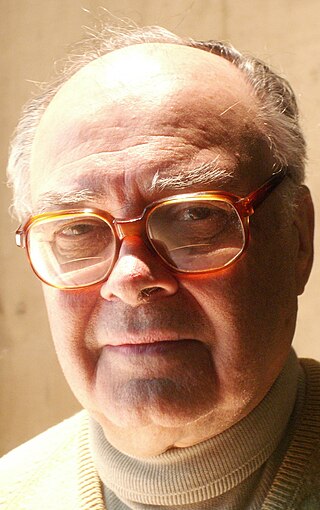
Hermann B. W. Mucke was an Austrian astronomer and one of the most significant promoters of amateur astronomy in German-speaking Europe. He was born and died in Vienna.
Oswald Thomas, was an astronomer and a protagonist of the popularization of astronomy in Germany and Austria.
Robert Hofferer is an Austrian film and theatre producer and a cultural manager.

Ludwig Wüst is an Austrian film director, scriptwriter and producer.

Werner Gruber is an Austrian physicist, author, lecturer, and cabaret artist and is well known from ORF and as a member of the Social Democratic Party of Austria (SPÖ).
The Holocaust in Austria was the systematic persecution, plunder and extermination of Jews by German and Austrian Nazis from 1938 to 1945. Part of the wider-Holocaust, pervasive persecution of Jews was immediate after the German annexation of Austria, known as the Anschluss. An estimated 70,000 Jews were murdered and 125,000 forced to flee Austria as refugees.
Carl Julius Haidvogel was born to Carl Haidvogel and Juliana on 13 September 1891 in Vienna, Austria. From 1912, Haidvogel worked as a registrar for the municipality of Vienna, was a part-time editor at the public educational institute and observatory Urania, and a dramaturge at the Bühne der Jungen. He started publishing his famous literary works in 1918. In the 1920s, he came into contact with the "Weekend and Settlement Movement" of the Viennese municipal Councillor Anton Weber, which also influenced his work. In 1937, Haidvogel joined the "Union of German Writers in Austria". Although Haidvogel was not among the contributors to the Confession Book of the "Union of German Writers of Austria" (BdSÖ), he was one of the signatories of the "Confession of the Union of German Writers to the Führer", published in Grazer Tagespost on 27 March 1938. Haidvogel was friends with Josef Weinheber and Karl Heinrich Waggerl. Haidvogel's work "The Pillars of God" was placed on the list of banned authors and books in Austria in 1946. In 1956, Haidvogel was retired. In 1971, he received the Austrian Decoration for Science and Art. He welcomed his son Gerhard with wife Lotte on 14 January 1921; Gerhard became the famous Austrian architect Gerhard Haidvogel. Carl Julius Haidvogel died on 26 December 1974 in Graz.
